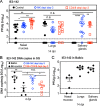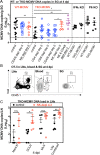Hematopoietic cell-mediated dissemination of murine cytomegalovirus is regulated by NK cells and immune evasion
- PMID: 33508041
- PMCID: PMC7872266
- DOI: 10.1371/journal.ppat.1009255
Hematopoietic cell-mediated dissemination of murine cytomegalovirus is regulated by NK cells and immune evasion
Abstract
Cytomegalovirus (CMV) causes clinically important diseases in immune compromised and immune immature individuals. Based largely on work in the mouse model of murine (M)CMV, there is a consensus that myeloid cells are important for disseminating CMV from the site of infection. In theory, such dissemination should expose CMV to cell-mediated immunity and thus necessitate evasion of T cells and NK cells. However, this hypothesis remains untested. We constructed a recombinant MCMV encoding target sites for the hematopoietic specific miRNA miR-142-3p in the essential viral gene IE3. This virus disseminated poorly to the salivary gland following intranasal or footpad infections but not following intraperitoneal infection in C57BL/6 mice, demonstrating that dissemination by hematopoietic cells is essential for specific routes of infection. Remarkably, depletion of NK cells or T cells restored dissemination of this virus in C57BL/6 mice after intranasal infection, while dissemination occurred normally in BALB/c mice, which lack strong NK cell control of MCMV. These data show that cell-mediated immunity is responsible for restricting MCMV to hematopoietic cell-mediated dissemination. Infected hematopoietic cells avoided cell-mediated immunity via three immune evasion genes that modulate class I MHC and NKG2D ligands (m04, m06 and m152). MCMV lacking these 3 genes spread poorly to the salivary gland unless NK cells were depleted, but also failed to replicate persistently in either the nasal mucosa or salivary gland unless CD8+ T cells were depleted. Surprisingly, CD8+ T cells primed after intranasal infection required CD4+ T cell help to expand and become functional. Together, our data suggest that MCMV can use both hematopoietic cell-dependent and -independent means of dissemination after intranasal infection and that cell mediated immune responses restrict dissemination to infected hematopoietic cells, which are protected from NK cells during dissemination by viral immune evasion. In contrast, viral replication within mucosal tissues depends on evasion of T cells.
Conflict of interest statement
The authors have declared that no competing interests exist.
Figures





Similar articles
-
Viral interference with antigen presentation does not alter acute or chronic CD8 T cell immunodominance in murine cytomegalovirus infection.J Immunol. 2007 Jun 1;178(11):7235-41. doi: 10.4049/jimmunol.178.11.7235. J Immunol. 2007. PMID: 17513772
-
The putative natural killer decoy early gene m04 (gp34) of murine cytomegalovirus encodes an antigenic peptide recognized by protective antiviral CD8 T cells.J Virol. 2000 Feb;74(4):1871-84. doi: 10.1128/jvi.74.4.1871-1884.2000. J Virol. 2000. PMID: 10644360 Free PMC article.
-
Mouse Cytomegalovirus m153 Protein Stabilizes Expression of the Inhibitory NKR-P1B Ligand Clr-b.J Virol. 2019 Dec 12;94(1):e01220-19. doi: 10.1128/JVI.01220-19. Print 2019 Dec 12. J Virol. 2019. PMID: 31597762 Free PMC article.
-
Host-Adapted Gene Families Involved in Murine Cytomegalovirus Immune Evasion.Viruses. 2022 Jan 11;14(1):128. doi: 10.3390/v14010128. Viruses. 2022. PMID: 35062332 Free PMC article. Review.
-
Cytomegalovirus immune evasion sets the functional avidity threshold for protection by CD8 T cells.Med Microbiol Immunol. 2023 Apr;212(2):153-163. doi: 10.1007/s00430-022-00733-w. Epub 2022 Apr 1. Med Microbiol Immunol. 2023. PMID: 35364731 Free PMC article. Review.
Cited by
-
Immune surveillance of cytomegalovirus in tissues.Cell Mol Immunol. 2024 Sep;21(9):959-981. doi: 10.1038/s41423-024-01186-2. Epub 2024 Aug 12. Cell Mol Immunol. 2024. PMID: 39134803 Free PMC article. Review.
-
New intranasal and injectable gene therapy for healthy life extension.Proc Natl Acad Sci U S A. 2022 May 17;119(20):e2121499119. doi: 10.1073/pnas.2121499119. Epub 2022 May 10. Proc Natl Acad Sci U S A. 2022. Retraction in: Proc Natl Acad Sci U S A. 2025 Aug 19;122(33):e2519570122. doi: 10.1073/pnas.2519570122. PMID: 35537048 Free PMC article. Retracted.
-
Pathogenic Exploitation of Lymphatic Vessels.Cells. 2022 Mar 12;11(6):979. doi: 10.3390/cells11060979. Cells. 2022. PMID: 35326430 Free PMC article. Review.
-
Multiple Autonomous Cell Death Suppression Strategies Ensure Cytomegalovirus Fitness.Viruses. 2021 Aug 27;13(9):1707. doi: 10.3390/v13091707. Viruses. 2021. PMID: 34578288 Free PMC article.
-
Comparability of CMV DNA Extraction Methods and Validation of Viral Load.Methods Protoc. 2022 Jan 4;5(1):6. doi: 10.3390/mps5010006. Methods Protoc. 2022. PMID: 35076560 Free PMC article.
References
Publication types
MeSH terms
Grants and funding
LinkOut - more resources
Full Text Sources
Other Literature Sources
Research Materials

